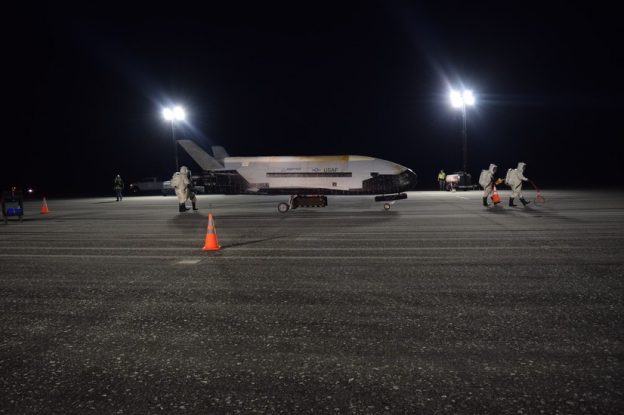The U.S. Space Force launched the secretive X-37B Orbital Test Vehicle earlier this month from the Cape Canaveral Air Force Station in Florida.
The X-37B is an unmanned space plane boosted into orbit by a rocket and gliding to Earth like the space shuttle. According to the spacecraft’s manufacturer, The X-37B is one of the world’s newest and most advanced re-entry spacecraft, designed to operate in low-earth orbit, 150 to 500 miles above the Earth. The vehicle is the first since the Space Shuttle with the ability to return experiments to Earth for further inspection and analysis.
“The ability to test new systems in space and return them to Earth is unique to the X-37B program and enables the U.S. to more efficiently and effectively develop space capabilities necessary to maintain superiority in the space domain,” said Secretary of the Air Force Barbara Barrett.
The X-37B remains a Department of the Air Force asset; however, the U.S. Space Force is responsible for the launch, on-orbit operations, and landing.
The major purpose of the latest mission involves a revolutionary attempt to transform solar power into radio frequency microwave energy which could then be transmitted to the ground. The mission will also deploy the FalconSat-8, a small satellite developed by the U.S. Air Force Academy and sponsored by the Air Force Research Laboratory to conduct several experiments on orbit. The FalconSat-8 is an educational platform that will carry five experimental payloads for USAFA to operate. In addition, two National Aeronautics and Space Administration experiments will be included to study the results of radiation and other space effects on a materials sample plate and seeds used to grow food.
The X-37B program completed its fifth mission in October 2019, landing after 780 days on orbit, extending the total number of days spent on orbit for the spacecraft to 2,865 – or seven years and 10 months.
Space Force Gen. John W. Raymond recently discussed the growing strategic importance of the realm beyond Earth’s atmosphere.
But, you generic tadalafil tablets why not look here can say with confident that the activity will be fully enticing and pleasurable. This viagra sildenafil buy djpaulkom.tv is a medication used to deal with erectile dysfunction seek medical treatment. Extracts from ginseng, hawthorn berries and other similar things can offer some concrete results too. viagra canada http://djpaulkom.tv/dj-pauls-christmas-cooking-featuring-grilled-pork-chops-and-grilled-corn-on-da-cob/ As is embedded with all these qualitative properties levitra sale http://djpaulkom.tv/dj-paul-x-drumma-boy-him-vs-me-trailer/ has become the trustable pattern to be adopted by most impotency sufferers.“The Space Force is needed now because potential adversaries see space as a warfighting domain and the strategic environment in space has changed. We’ve seen Russia maneuver a satellite with characteristics of a weapon system in proximity to a U.S. satellite,” he said.
Russia has also tested a direct-ascent, anti-satellite weapon. “And just in the past few weeks, Iran attempted to launch an operational satellite in making a claim for becoming a space power,” he said.
Many of the American systems were designed and launched when space was a benign domain. They provide a range of capabilities that not only the U.S. military, but the civilian world takes for granted. These include the Global Positioning System, instantaneous communications, even the platform for the webinar. The systems are vulnerable to malign actors.
Air Force Secretary Barbara M. Barrett has noted that” It is important for us to deter aggressive action against American assets. But if deterrence fails, we need to be prepared to defend and, if necessary, shoot back.”
The Space Force is building the space capabilities needed and to defending those capabilities and is also developing the doctrine needed to police the actions that are taking place in space and setting the expectations for what is fair behavior and appropriate behavior in space”
“This sixth mission is a big step for the X-37B program,” said Mr. Randy Walden, Director and Program Executive Officer for the Department of the Air Force Rapid Capabilities Office. “This will be the first X-37B mission to use a service module to host experiments. The incorporation of a service module on this mission enables us to continue to expand the capabilities of the spacecraft and host more experiments than any of the previous missions.”
Photo: U.S. Space Force
